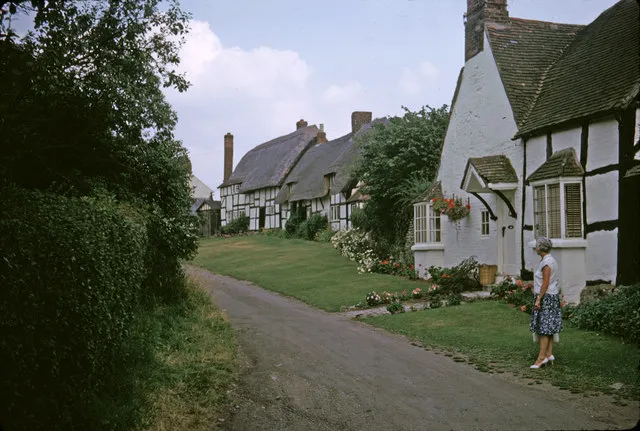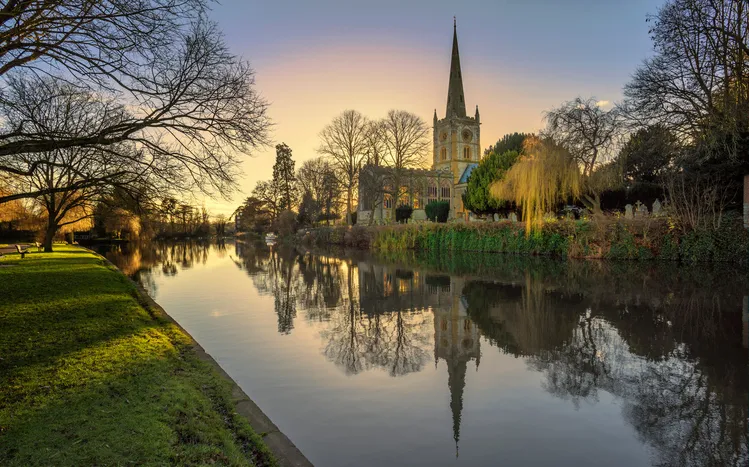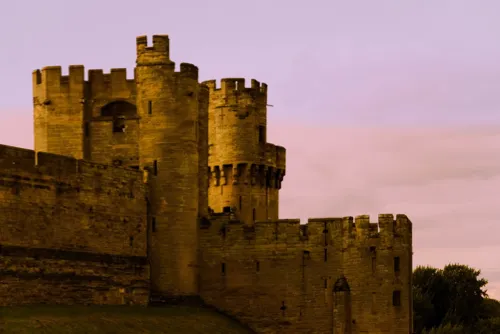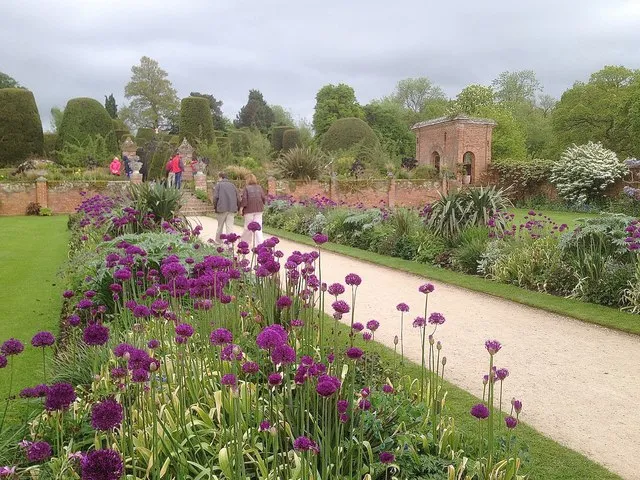Here is our guide to the Midlands, looking at the best villages, country houses and castles to visit, plus places to eat and stay.
What does Meriden mean?
No one knows how Meriden, near Coventry came to be known as the centre of England for more than 500 years. Maybe it began with drovers moving livestock diagonally through the country, finding Meriden to be three days from London and three days from Chester. Maybe it was dreamed up by tallow light in the Bull’s Head: a novel way to draw coaches to the inn. Geographically it wasn’t a farfetched imagining, though, and nor is viewing the old boundaries of Warwickshire as England’s symbolic heart.
On Meriden village green in the West Midlands (formerly Warwickshire), a 1951 plaque declares that the wayside cross above it marks the traditional centre of England.
Where is the new centre of England?
According to more recent (and accurate) calculations by Ordnance Survey in 2002, the geographic centre of England has been found to be a field at Lindley Hall Farm in Leicestershire – 11 miles from the original site.
What are the Midlands counties?
Landlocked Warwickshire borders with seven Midlands counties: Leicestershire and Staffordshire in the north and Gloucestershire and northern Oxfordshire in the south, its feet in the golden Cotswolds. To the east, Northamptonshire, the Rose of the Shires, and in the west, Worcestershire and the West Midlands, where JRR Tolkien’s imagination would take flight to create the rustic Shire of Middle Earth. Warwickshire is the county Henry James described as “mid-most England, unmitigated England”: wooded, undulating, and largely undramatic until met with half-timbered houses and lias-built (lias is a kind of limestone) churches. There it becomes idyllic. This is the home of modern rugby, George Eliot, and a playwright we’ll meet soon.
The best villages to visit in the Midlands
Welford-on-Avon
Of the many villages waiting to catch our eye, Welford-on-Avon is also one of the prettiest. Set in a bend of the River Avon, four miles south-west of Stratford-upon-Avon, it has a Norman church perched above timber-framed cottages, which are rendered plump and endearing with white- painted plaster and bonny thatched heads. Local lore has made the flagstone floors and cosy replaces of the 17th-century Bell Inn the scene of our unmentioned writer’s final ‘merry meeting’. Easier to prove is Welford’s other most English of boasts: to have one of the country’s tallest maypoles.

Berkswell
Six miles west of Coventry is a village telling tales that span centuries: Berkswell, whose name may derive from Bercul, a Saxon chieftain, and the spring-fed well in which he was reputedly baptised. The village green still displays stocks, inexplicably five-holed; some say it accommodated an unruly one-legged former soldier and his two drinking companions. In Berkswell’s handsome church of St John the Baptist, take the steps leading down from a boxed pew in the north aisle to find a two-part Norman crypt. The church is full of surprises, including signature mouse carvings by Robert Thompson (1876–1955). Its grounds hold a celebrity from the heart of English sport, for this is the burial place of Maud Watson, the 1884 winner of the first Ladies’ Singles title at Wimbledon.
Best places for wildlife spotting in the Midlands
To see England’s central landscape reclaimed by nature, look to Brandon Marsh, in the loving care of Warwickshire Wildlife Trust. More than 220 species of bird have been recorded here; you can view their soaring and hear their song from eight different hides. Take the longest of three footpaths, Kingfisher Trail, to walk alongside willow carr (waterlogged woodland), through trees and grassland, past the Newlands reedbed, which has been cultivated to nurture eels and amphibians. In later spring, the oak and ash shade of New Hare Covert will yield bluebells and foxgloves.
Although appearing wild and old, Brandon Marsh was formed by subsidence and flooding due to nearby coal mining, and sand and gravel workings until the 1980s invited further stretches of open water. The hands of industry have wrought further legacies on central England’s landscape through canals, those extraordinary feats of engineering that also foster tranquillity. A place to appreciate both is Hatton, where the Grand Union Canal takes a flight of 21 locks over 4km, raising the water by a remarkable 45 metres. This ‘stairway to heaven’ is blessed with biodiversity: look for darting dragon flies and damselflies in the summer and, all year round, listen for the telltale yaffle of the green woodpecker.
Best country houses and castles to visit for history
Stratford-upon-Avon
Near where the Stratford-upon-Avon canal meets the River Avon you’re likely to find Shakee’s Ice Cream Boat moored in wait for a new season of bard-watchers. Here is where we realise Warwickshire is not only the heart of England but, when it comes to our unnamed writer, the centre of the universe. “They’re Shakespeare-mad around here, aren’t they?” I heard a bemused visitor say on Bridge Street. Well, yes. But forgivably so.

Stratford and the Shakespeare Birthplace Trust properties lie on well-trodden trails, so instead, let’s seek our man four miles east of the town, at Charlecote Park, the 800-year-old home of the Lucy family. Here you can follow footpaths among four shades of fallow deer, imagining a young William Shakespeare poaching a few, and perhaps some rabbits. A lack of compelling evidence has not hindered this story’s popularity. Shakespeare would at least have known Charlecote’s parkland and been aware of the Lucys, though. Be sure to visit the pristine knights’ tombs in the Lucy Chapel of St Leonard’s Church. Some people think Sir Thomas Lucy (d.1600) was sent up by Shakespeare as Justice Robert Shallow in The Merry Wives of Windsor.
Woodland assumes significance in several Shakespeare plays, especially As You Like It, where the court moves out into the Forest of Arden, cueing mischief and confusion. Little remains now of the thick old forest, which once stretched from Stratford to Tamworth, swathing the world Shakespeare knew in oak trees. Today, we find the forest’s legacy in place names: Henley-, Tanworth-, Hampton-in-Arden, and the many villages whose names end with the Saxon su x -ley or -leigh, denoting a woodland clearing. On the corner of Coughton Fields Lane outside Coughton Court near Alcester, a crumbly stone monument marks the supposed spot where travellers prayed for safe passage through the forest.

Warwick Castle
If we avoid Stratford, then nor should we linger in Leamington Spa, Coventry or Warwick. Looking out from a sandstone bluff over a bend in the River Avon, Warwick Castle must be mentioned, however, for its exhilarating combination of history and majesty. This is one of England’s nest medieval castles, replacing a motte- and-bailey fort built by William the Conqueror. The theme park-ish overlay brought by modern-day management from Merlin Entertainments makes a visit fun for anyone, with unwitting absorption of history lessons almost guaranteed through birds-of-prey displays, jousting and the ring of a missile from the world’s biggest working trebuchet. (The projectile is no longer sent flaming, following a 2015 mishap involving a Victorian thatched boathouse.) Even with crowds, 64 acres of Capability Brown landscape provide space to wander, and a home for peacocks both living and topiary.
While Ambrose Dudley, Earl of Warwick, was in residence at Warwick Castle, his brother Robert had been given Kenilworth Castle by Elizabeth I. Robert was the queen’s favourite suitor until his death in 1588; the only man she would have married. His alterations, architecturally and politically ambitious, are visible throughout the castle grounds today and the story of his thwarted desire is told comprehensively by English Heritage. Stairs and viewing platforms installed in Leicester’s Building allow visitors to ascend the red sandstone ruins and look out to the Warwickshire Queen Elizabeth would have seen during the whirl of banqueting, sport and dancing that accompanied her royal progress.

Political history – sites to visit
Two years after Elizabeth’s death, a group of provincial English Catholics schemed to blow up the Houses of Parliament. The history of several Warwickshire families is charged through with links to the Gunpowder Plot, including the Throckmortons of Coughton Court and possibly the Ferrers of Baddesley Clinton.
The latter house, magnificent and moated, has priest-holes, and a tale of earlier intrigue. One day in 1485, the lord of the manor Nicholas Brome came home to find a man “chockinge” (‘chucking’ or stroking) Brome’s wife Elizabeth “under ye chinne”. In a jealous rage, Brome drew his sword and killed the stranger, only to discover he had murdered the Rector of St James. For this killing, and the earlier death of a steward in a fight, Brome was ordered to pay penance, which included renovating the local church. And so the towers of St Michael’s Church in Baddesley Clinton and St Giles in Packwood are known as the Towers of Atonement.
It seems Brome carried his remorse to the grave because, upon a request stated in his will, he was buried standing upright in St Michael’s: “Within the church door as the people may tread upon mee as they cone [sic] into the church”.

Country houses to visit
Baddesley Clinton and Packwood House – two more names hinting at Warwickshire’s sylvan past – are managed by the National Trust and worth visiting in one day, especially if you can make the four-mile walk between estates, partly following the canal towpath. Packwood’s yew trees are startling: over 350 years old, they’re clipped into curious conical and cylindrical shapes. When I learned the topiary may represent evangelists and apostles at the Sermon on the Mount I smiled a bit guiltily. Because that would mean the arbour overseeing them all – the one with the spiral pathway my boys love to hurtle down yelling “Helter- skelter!” – is meant to be Jesus. I’ll urge them to proceed more reverently in future.
But I’m glad they have the trees and rural scenes of Warwickshire in the landscape of their childhood. Blessed are they who enjoy the endlessly captivating heart of England.
